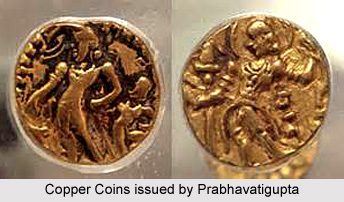 Prabhavati Gupta was the royal regent and queen who belonged to the Vakataka Dynasty and daughter of Chandragupta II of the Gupta Empire. `Kuberanaga`, a Naga woman was the mother of Prabhavati Gupta. Queen Prabhavati Gupta wedded King Rudrasena II of the Vakataka Empire and she had controlled the reigns of her empire in 385 CE following the demise of her husband. She ruled as a royal regent on the behalf of two of her sons named Damodarasena and Divakarasena for 13 years. At the time of the death of Rudra Sena II, his two minor sons, were 5 and 2 years old respectively. Her father Chandragupta II extended his cooperation towards Prabhavati Gupta in the supervision of her kingdom. Therefore the influence of the Guptas became more prominent and stronger in the empire of the Vakatakas during this period. That is why copper plates of Prabhavati Gupta mention details of Gupta dynasty, along with the dynasties of Vakataka dynasty.
Prabhavati Gupta was the royal regent and queen who belonged to the Vakataka Dynasty and daughter of Chandragupta II of the Gupta Empire. `Kuberanaga`, a Naga woman was the mother of Prabhavati Gupta. Queen Prabhavati Gupta wedded King Rudrasena II of the Vakataka Empire and she had controlled the reigns of her empire in 385 CE following the demise of her husband. She ruled as a royal regent on the behalf of two of her sons named Damodarasena and Divakarasena for 13 years. At the time of the death of Rudra Sena II, his two minor sons, were 5 and 2 years old respectively. Her father Chandragupta II extended his cooperation towards Prabhavati Gupta in the supervision of her kingdom. Therefore the influence of the Guptas became more prominent and stronger in the empire of the Vakatakas during this period. That is why copper plates of Prabhavati Gupta mention details of Gupta dynasty, along with the dynasties of Vakataka dynasty.
Prabhavati Gupta is known to have issued Poona copper plate inscription during the final and 13th year of her regime, as the mother of the prince Divakarasena. During the 19th year of the reign of Prabhavati Gupta`s son Pravarasena II, copper plates had been issued in Riddhapur on which were inscribed that Prabhavati Gupta was the mother of Pravarasena II as well as Damodarasena. Some scholars are of the view that these copper plates were written by Gupta officers who lived in the kingdom of the Vakatakas. It is also said that Chandra Gupta had sent Kalidas to Vakataka kingdom to teach his grandsons-in-law. It is also said that Pravarsena II i.e. Damodar Sena had written a book named `Setubandhu` which was corrected or edited by Kalidas himself.
Prabhavati Gupta had proclaimed herself to as a lady belonging to the `gotra` of `Dharana`, particularly in her Riddhapur and also Poona copper plate inscriptions. It is believed that Prabhavati Gupta`s father also had the Dharana Gotra, as has been referred to in the inscription of the copper plates issued by Pravarasena II. During the reign of Prabhavati Gupta, Chandra Gupta II had attacked and defeated the Sakas. As a result of the defeat of the Sakas the provinces of Gujarat and Kathiawar were also included in the Gupta Empire. In the said war with the sakas, Prabhavati Gupta must have helped his father.
During the regent ship of Prabhavati Gupta, Diwakarasena had died and the younger son Damodarasena became the king on attaining the majority.



















